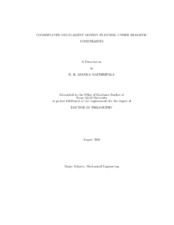| dc.contributor.advisor | Suhada, Jayasuriya | |
| dc.creator | Maithripala, Diyogu Hennadige Asanka | |
| dc.date.accessioned | 2010-01-15T00:08:30Z | |
| dc.date.accessioned | 2010-01-16T01:11:50Z | |
| dc.date.available | 2010-01-15T00:08:30Z | |
| dc.date.available | 2010-01-16T01:11:50Z | |
| dc.date.created | 2008-08 | |
| dc.date.issued | 2009-05-15 | |
| dc.identifier.uri | https://hdl.handle.net/1969.1/ETD-TAMU-3007 | |
| dc.description.abstract | Considered is a class of cooperative control problems that has a special affine characterization.
Included in this class of multi-agent problems are the so called radar
deception problem, formation keeping and formation reconfiguration. An intrinsic geometric
formulation of the associated constraints unifies this class of problems and it
is the first time such a generalization has been presented. Based on this geometric formulation,
a real-time motion planning algorithm is proposed to generate dynamically
feasible reference trajectories for the class. The proposed approach explicitly considers
actuator and operating constraints of the individual agents and constrained dynamics
are derived intrinsically for the multi-agent system which makes these constraints
transparent. Deriving the constrained dynamics eliminates the need for nonlinear
programming to account for the system constraints, making the approach amenable
to real-time control. Explicit consideration of actuator and operating limitations and
nonholonomic constraints in the design of the reference trajectories addresses the important
issue of dynamic feasibility. The motion planning algorithm developed here
is verified through simulations for the radar deception, rigid formation keeping and
formation reconfiguration problems.
A key objective of this study is to advocate a change in paradigm in the approach
to formation control by addressing the key issues of dynamic feasibility and
computational complexity. The other important contributions of this study are: Unifying formulation of constrained dynamics for a class of problems in formation control
through the intrinsic geometry of their nonholonomic and holonomic constraints; Deriving
these constrained dynamics in any choice of frame that can even be coordinate
free; Explicit consideration of actuator and operating limits in formation control to
design dynamically feasible reference trajectories and Developing a real-time, distributed,
scalable motion planning algorithm applicable to a class of autonomous
multi-agent systems in formation control. | en |
| dc.format.medium | electronic | en |
| dc.format.mimetype | application/pdf | |
| dc.language.iso | en_US | |
| dc.subject | trajectory generation | en |
| dc.subject | real-time guidance | en |
| dc.title | Coordinated Multi-Agent Motion Planning Under Realistic Constraints | en |
| dc.type | Book | en |
| dc.type | Thesis | en |
| thesis.degree.department | Mechanical Engineering | en |
| thesis.degree.discipline | Mechanical Engineering | en |
| thesis.degree.grantor | Texas A&M University | en |
| thesis.degree.name | Doctor of Philosophy | en |
| thesis.degree.level | Doctoral | en |
| dc.contributor.committeeMember | Alexander, Parlos | |
| dc.contributor.committeeMember | Aniruddha, Datta | |
| dc.contributor.committeeMember | Tamas, Kalmar-Nagy | |
| dc.type.genre | Electronic Dissertation | en |
| dc.type.material | text | en |
| dc.format.digitalOrigin | born digital | en |


